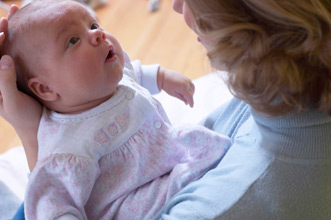Mandatory genetic screening of newborns for rare diseases is creating unexpected upheaval for families whose infants test positive for risk factors but show no immediate signs of disease, a new University of California Los Angeles
"Although newborn screening undoubtedly saves lives, some families are thrown on a journey of great uncertainty," said UCLA sociology professor Stefan Timmermans, the study's lead author. "Rather than providing clear-cut diagnoses, screening of an entire population has created ambiguity about whether infants truly have a disease--and even what the disease is."
The study appears in the December issue of the Journal of Health and Social Behavior. The National Science Foundation's (NSF) Social, Behavioral and Economic Sciences Directorate partially funded the work in support of a grant that aims to improve social science research strategies. Specifically, the grant funded a project to integrate methods, rules and systems of study for two research disciplines: conversation analysis and ethnography.
"The results of newborn screening are meaningless if we do not understand the communication processes and the ways families make sense of the information," said Patricia White, a Division of Social and Economic Sciences program manager at NSF. "This NSF-funded project is the first and most in-depth study in this important area."
Conversation analysis focuses on verbal communication for investigating social interaction, while ethnography is a method of study in which researchers participate in people's daily lives for an extended period of time to gather close observational data.
For three years, the research team followed 75 California
"It is obvious that positive newborn screening results have marked families' relationships with their child, their expectations for the child, and even their own relationship as a couple," said White.
"By showing the plight of families thrown unexpectedly into uncertainty about the health of their child, the research is encouraging the field of genetics and public health to speed up the process of follow-up testing and to conduct prospective studies of the health consequences of asymptomatic patients."
Timmermans describes these families as "the collateral damage of newborn screening," an unanticipated consequence of expanding mandatory screening begun in 2005.
"Basically you're telling families of a newborn, 'Congratulations, but your child may have a rare genetic condition. We just don't know, and we don't know when we'll know,'" Timmermans said.
Conducted with Mara Buchbinder, who earned a doctorate in anthropology at UCLA and is now an assistant professor of social medicine at the University of North Carolina-Chapel Hill, the study paints a picture of families caught in limbo as they wait months for conclusive evidence that their children are out of the woods for conditions that have been associated with schizophrenia, mental retardation, heart and lung disease, coma and sudden death.
In many cases, the medical results never come; the children slowly age out of having risk factors for up to 29 metabolic, endocrine or hemoglobin conditions. But by that time, some families are so traumatized that they follow unwarranted and complicated regimens for years afterward, including waking their children up in the middle of the night, enforcing restrictive diets and limiting contact with other people.
"When the test results ultimately suggest the risk is nothing or not as significant as with patients who are symptomatic, the physicians are ready to let go of preventative measures," Timmermans said. "But the parents are reluctant to give them up because they come to believe that they're keeping their child disease-free. Over and over again, we saw parents and doctors at odds."
The genetic testing of newborns dates back four decades, when the approach showed promise in identifying phenylketonuria, or PKU, a genetic disorder characterized by the body's inability to utilize an essential amino acid, phenylalanine. The disorder causes a build-up of phenylalanine in the blood, which can result in mental retardation, brain damage, seizures and other problems. But if PKU sufferers are identified early enough, they can avoid these problems through diet and medication.
The advent of new screening technologies in the late 1990s vastly increased the number of potential diseases that could be detected with a blood sample easily obtained by pricking the heel of a newborn. Genetic testing of newborns got another boost in 2005 when the American College U.S. District of Columbia California
"When the American College








No comments:
Post a Comment